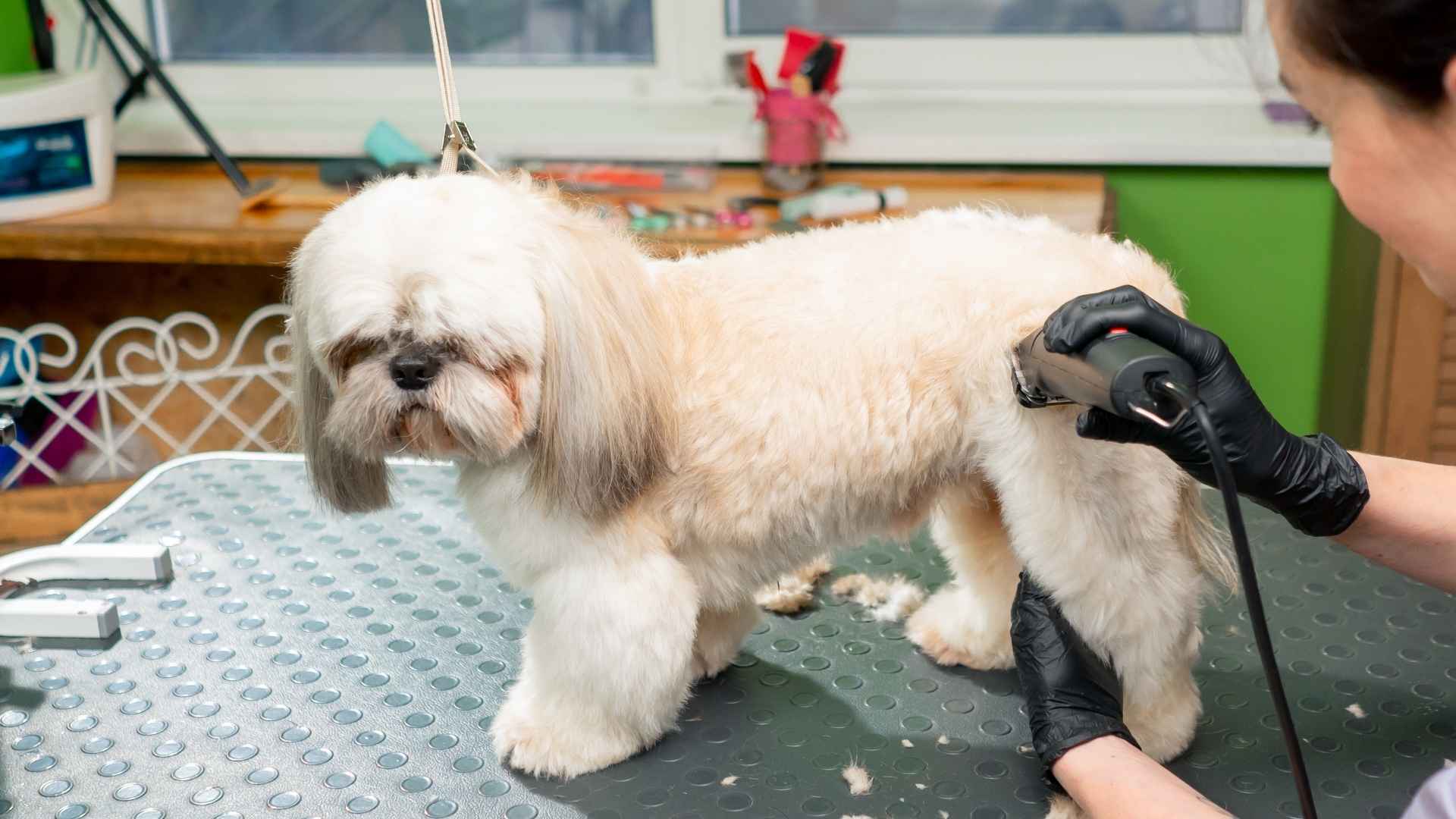Owning a dog with a luxurious, high-maintenance coat is rewarding and challenging. These fluffy companions turn heads with their gorgeous fur, but behind the beauty lies a commitment to regular grooming, upkeep, and care. Maintaining their coats requires time, effort, and the right tools, from daily brushing to professional trims.
If you love the idea of a glamorous, well-groomed pup, be prepared for the responsibility that comes with it. Neglecting coat care can lead to tangles, mats, and skin issues, making grooming an essential part of their routine. Beyond aesthetics, a well-maintained coat contributes to a dog’s overall health and comfort.
Whether you’re considering adopting a long-haired breed or already have one, understanding their grooming needs is crucial. In this guide, we’ll explore the breeds with high grooming needs and expert tips to keep their fur in top condition.
High-Maintenance Coat Dog Breeds
1. Puli
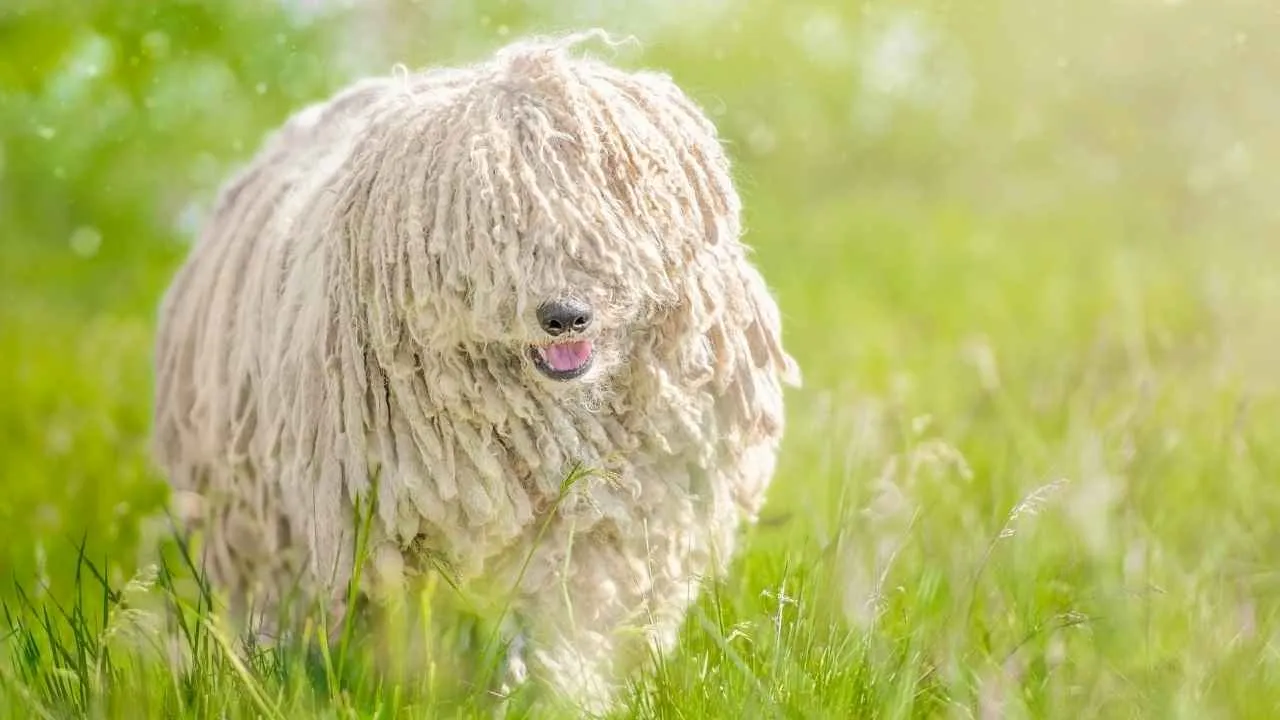
The Puli has a naturally corded coat that resembles long, thick dreadlocks. This distinctive fur isn’t just for looks—it protects against harsh weather and rough terrain. However, this coat requires patience, commitment, and specialized grooming techniques. The cords can easily trap dirt, moisture, and debris without proper care, leading to matting and skin infections.
Bathing is another challenge, as their dense fur absorbs water like a sponge, making drying an all-day process. If not dried thoroughly, trapped moisture can lead to odor and skin issues.
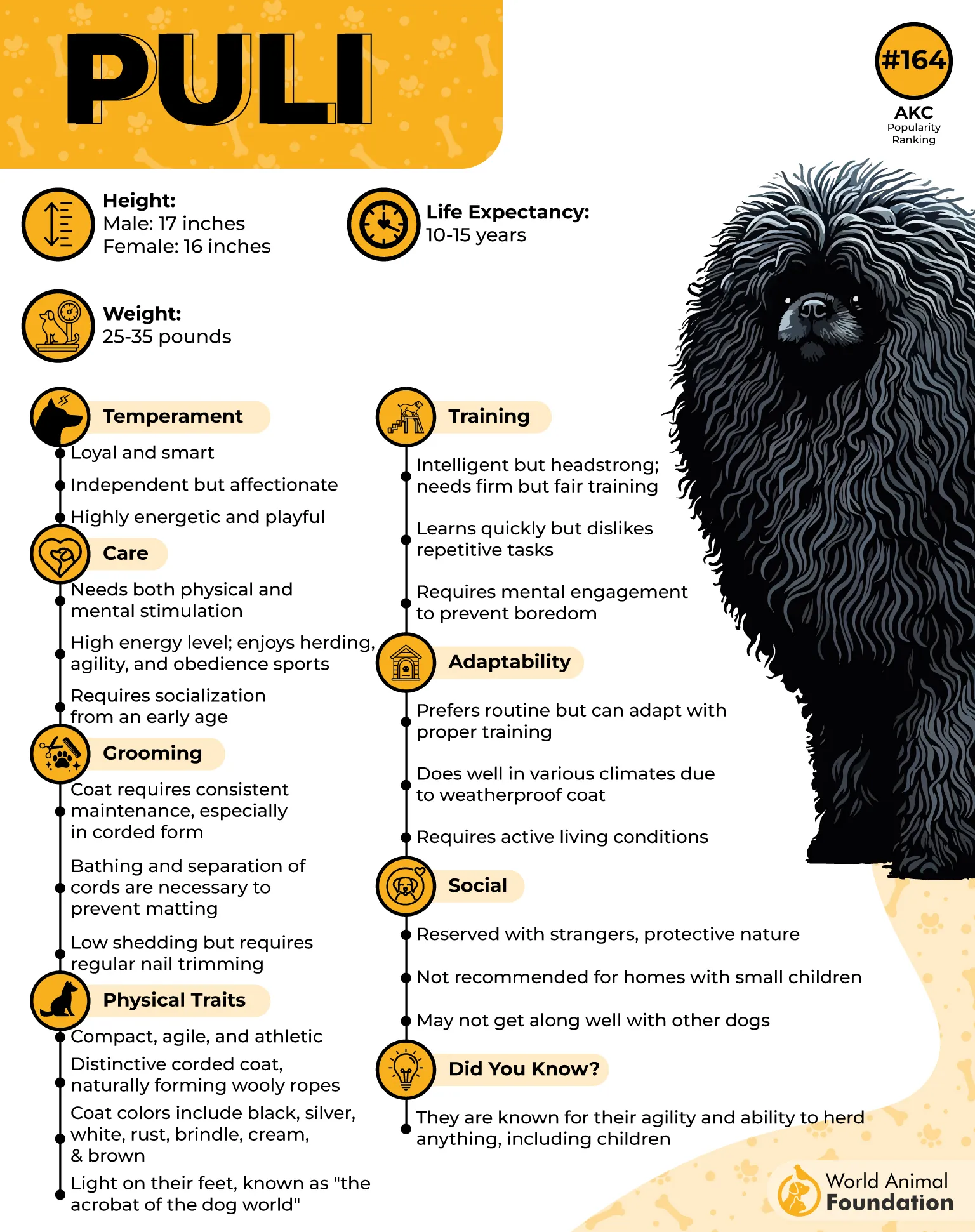
Regular maintenance is essential to keeping a Puli’s coat healthy. Owners must check for tangles, debris, and parasites hidden within the cords. Brushing is not an option with this breed; the cords must be gently pulled apart and maintained.
Professional grooming can help, but expertise is required to manage their unique fur texture. Some owners trim the coat short for easier upkeep, but this removes the breed’s signature look.
Beyond grooming, the Puli is an energetic, intelligent breed and thrives on activity. Their coat may require intensive care, but their personality makes them a rewarding companion. Owners must balance their grooming routine with exercise and mental stimulation to keep them happy. If neglected, it causes discomfort, but so can a lack of activity, as this breed was originally bred for herding.
Owning a Puli means committing to consistent coat care and a structured routine. While their signature look is eye-catching, it comes with responsibility. If you’re prepared for regular maintenance, patience, and extra effort, the Puli is a loyal, affectionate, and lively companion that stands out wherever it goes.
2. Afghan Hound

The Afghan Hound is one of the most elegant breeds, known for its long, silky fur that flows like a royal cloak. This stunning coat requires extensive grooming to maintain its beauty and prevent tangles. Afghan Hound’s fur is fine and delicate, making it prone to matting if not brushed regularly. A dedicated grooming routine is essential to keeping it smooth, shiny, and free from knots.
Regular brushing is a must, often requiring at least three to four grooming sessions per week. Their coat needs a high-quality pin brush and a wide-tooth comb to prevent breakage. Bathing is another frequent task, as their fur collects dirt easily.
Many owners use specialized shampoos and conditioners to maintain the silky texture, followed by careful drying to avoid frizz and tangling. A neglected coat can become a matted mess that’s difficult to restore.
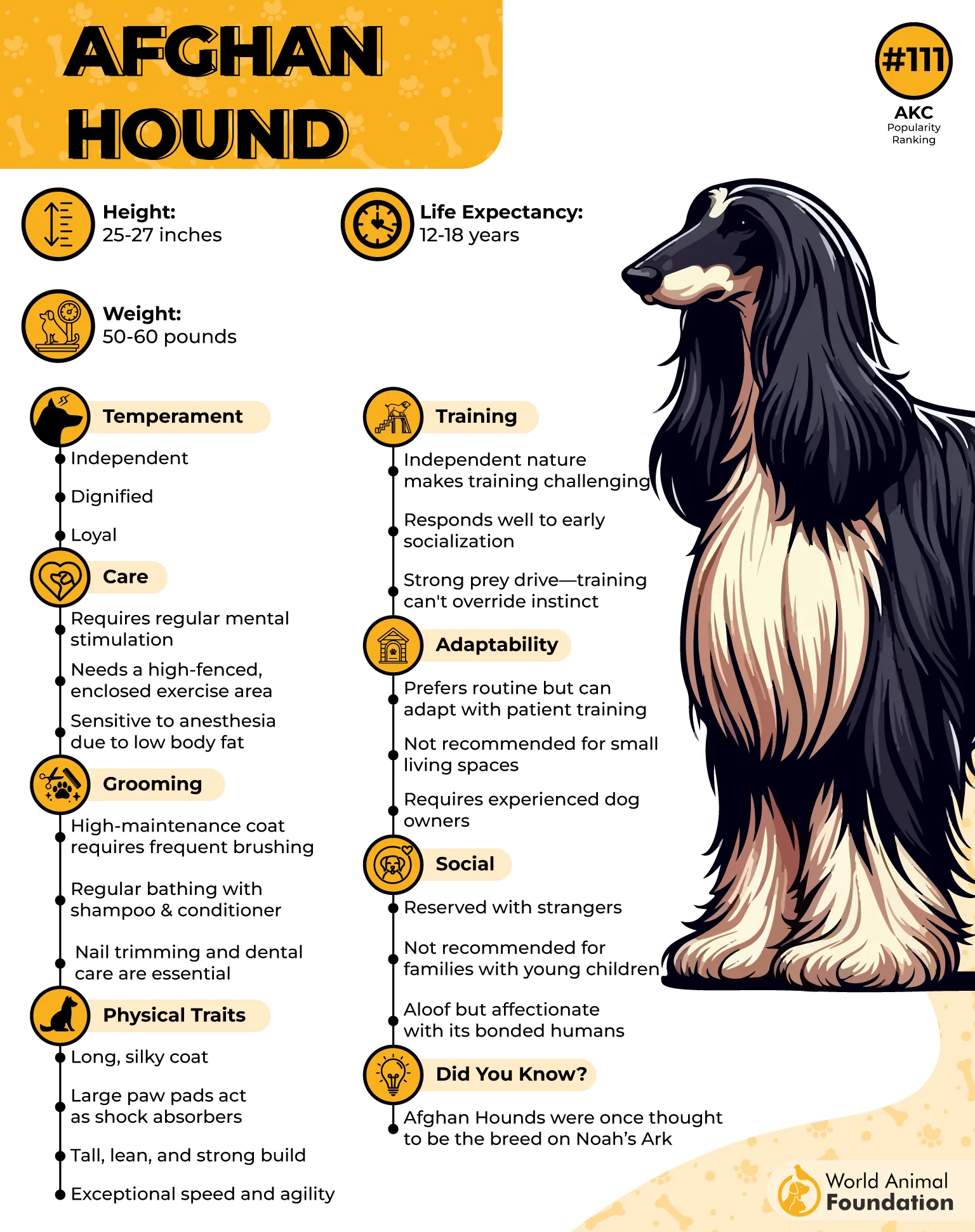
Beyond grooming, the Afghan Hound’s coat demands lifestyle adjustments. Their long fur can easily pick up debris, challenging for outdoor adventures. Wet or muddy conditions can be especially troublesome, requiring immediate cleaning.
Some owners tie their ears back during meals to keep them from dipping into food and water. This breed’s coat isn’t just for show—it demands time, effort, and continuous upkeep.
Afghan Hounds are independent, dignified, and affectionate dogs. They thrive in a peaceful environment and enjoy lounging after a good run. Their athletic build and high energy levels require regular exercise, but owners must be cautious in extreme weather. Their thin coat offers little insulation against the cold, while in warmer climates, excessive sun exposure can dry out their fur.
Owning an Afghan Hound is a commitment to both beauty and care. Their glamorous coat requires meticulous grooming, but you get a graceful, loving companion with an unmistakable presence in return. If you’re willing to put in the effort, this breed will reward you with elegance, charm, and unwavering loyalty.
3. Old English Sheepdog

The Old English Sheepdog is a classic example of high maintenance dog breed, recognized for its thick, shaggy double coat. While this fluffy fur gives them a charming, teddy bear-like appearance, it requires constant upkeep.
Their dense coat mats easily make daily brushing essential to prevent tangles and skin issues. Their fur can trap dirt, moisture, and debris without proper care, leading to discomfort and health problems.
Regular bathing is a crucial part of their grooming routine. Their thick coat absorbs water like a sponge, requiring thorough drying to prevent mildew-like odors and skin infections. Bathing frequently can strip natural oils, but going too long without washing can cause matting and hygiene issues.
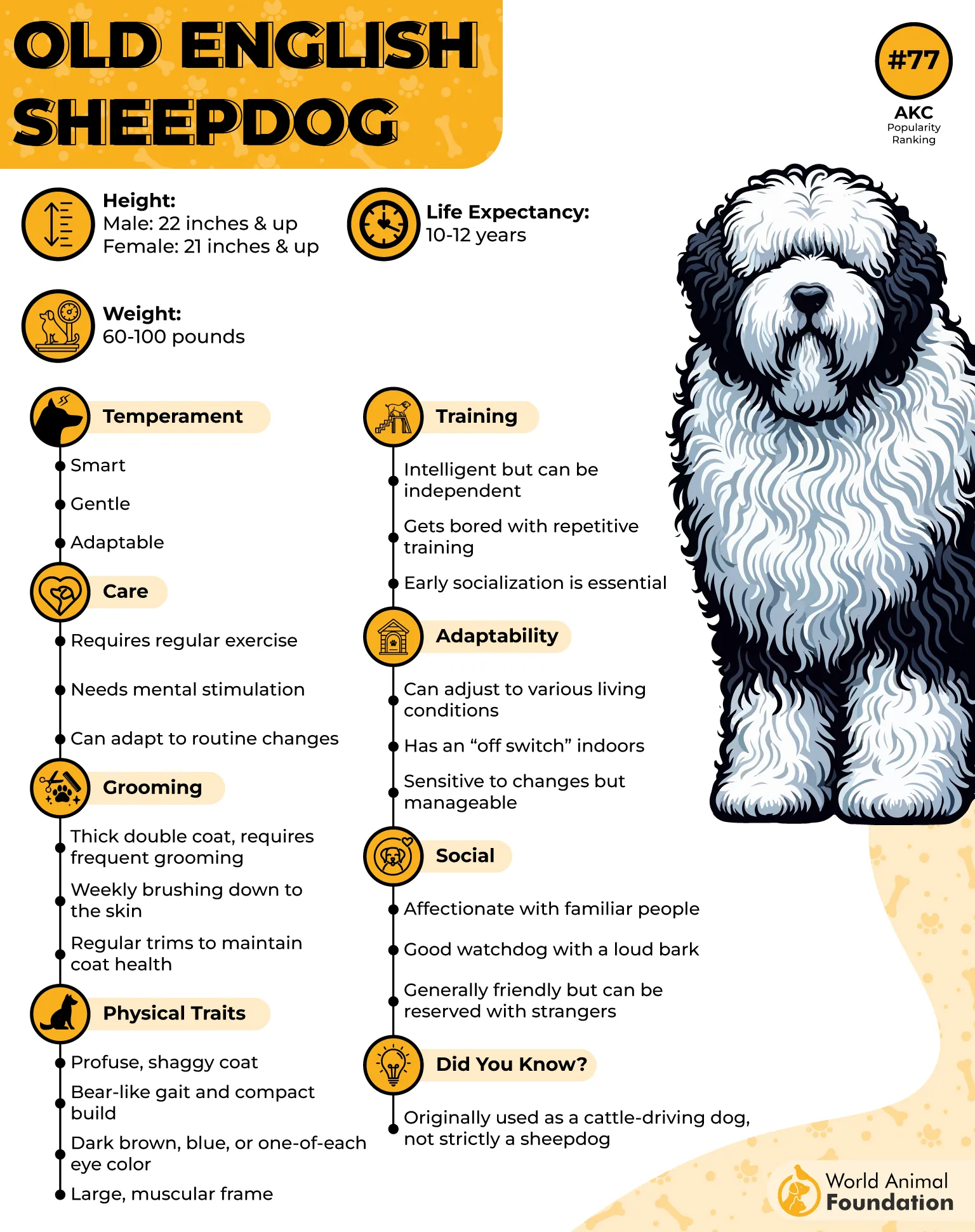
Grooming is time-consuming, requiring patience and dedication. Professional grooming is often necessary, especially for those who prefer a trimmed coat for easier upkeep. Without consistent care, their fur can become a tangled mess, making it painful for the dog and difficult for the owner to manage.
Their heavy coat also contributes to health problems if neglected. Overheating in warm climates is a major concern, as their thick fur retains heat. Proper grooming helps maintain airflow to their skin, reducing the risk of hot spots and irritation. Regular trims, especially around the eyes and paws, improve visibility and comfort, ensuring the dog stays healthy and active.
With their unique traits and lovable personality, Old English Sheepdogs make wonderful companions. Their playful spirit and affectionate nature make them great family dogs, but their coat care is a full-time responsibility. For those willing to invest the time, effort, and regular grooming, this breed offers loyalty, charm, and an unmistakable presence.
4. Chow Chow
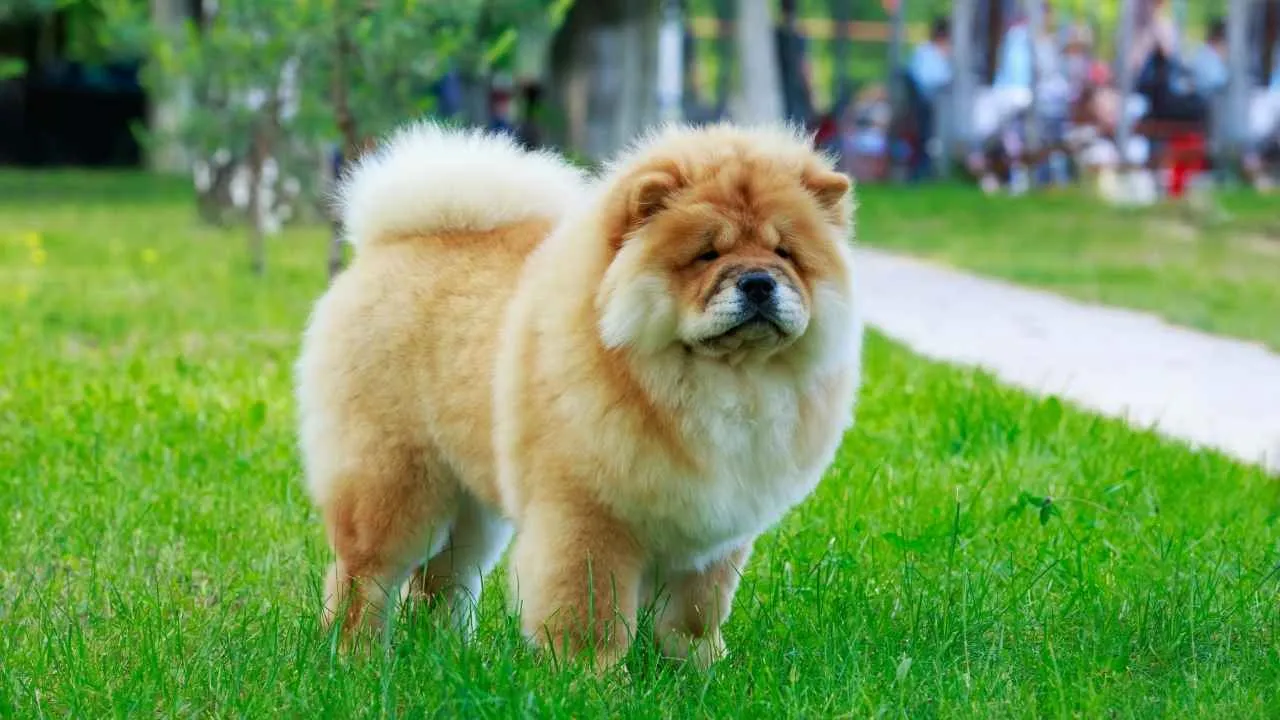
The Chow Chow is a distinctive and independent breed known for its dense double coat and signature blue-black tongue. This thick fur gives them a regal, lion-like appearance but also makes them one of the most high-maintenance double-coated dogs.
The dog’s coat can trap dirt and moisture, leading to matting, skin rolls, and irritation, especially in warmer climates. Proper grooming is essential to maintain their overall health and comfort.
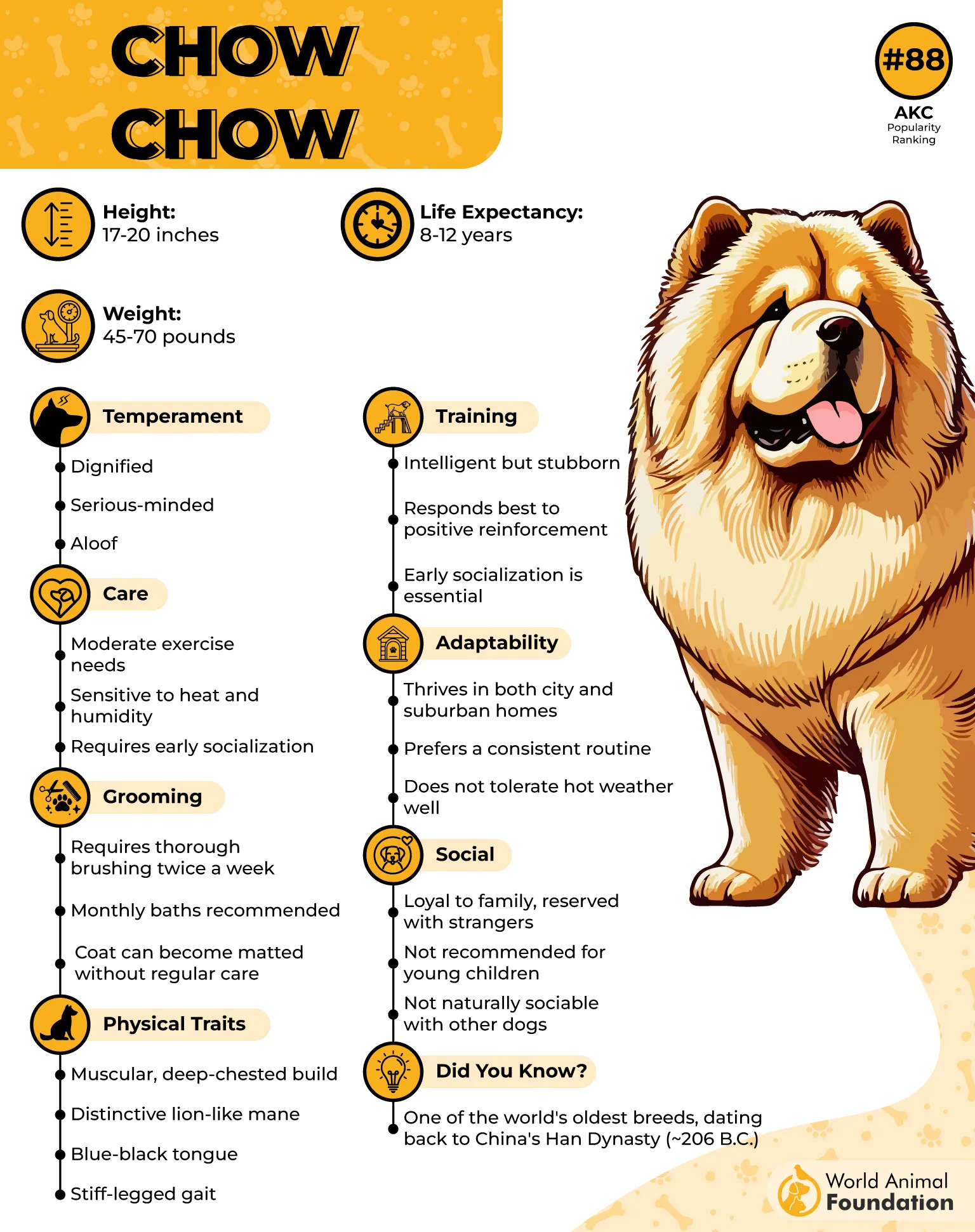
Shedding is a major concern, particularly during seasonal changes. Frequent brushing—at least three to four times weekly—helps remove loose hair and prevent tangles. Their coat requires a high-powered blow dryer after baths to ensure thorough drying and reduce the risk of trapped moisture.
While regular bathing is necessary, over-washing can strip natural oils, affecting coat health. Investing in proper grooming tools helps keep their fur manageable and debris-free.
Chow Chows have an aloof and independent nature, making obedience training crucial. Their strong-willed personality requires patience and structure from an early age. While they are not the most energetic breed, they still need daily engagement to prevent stubborn behaviors.
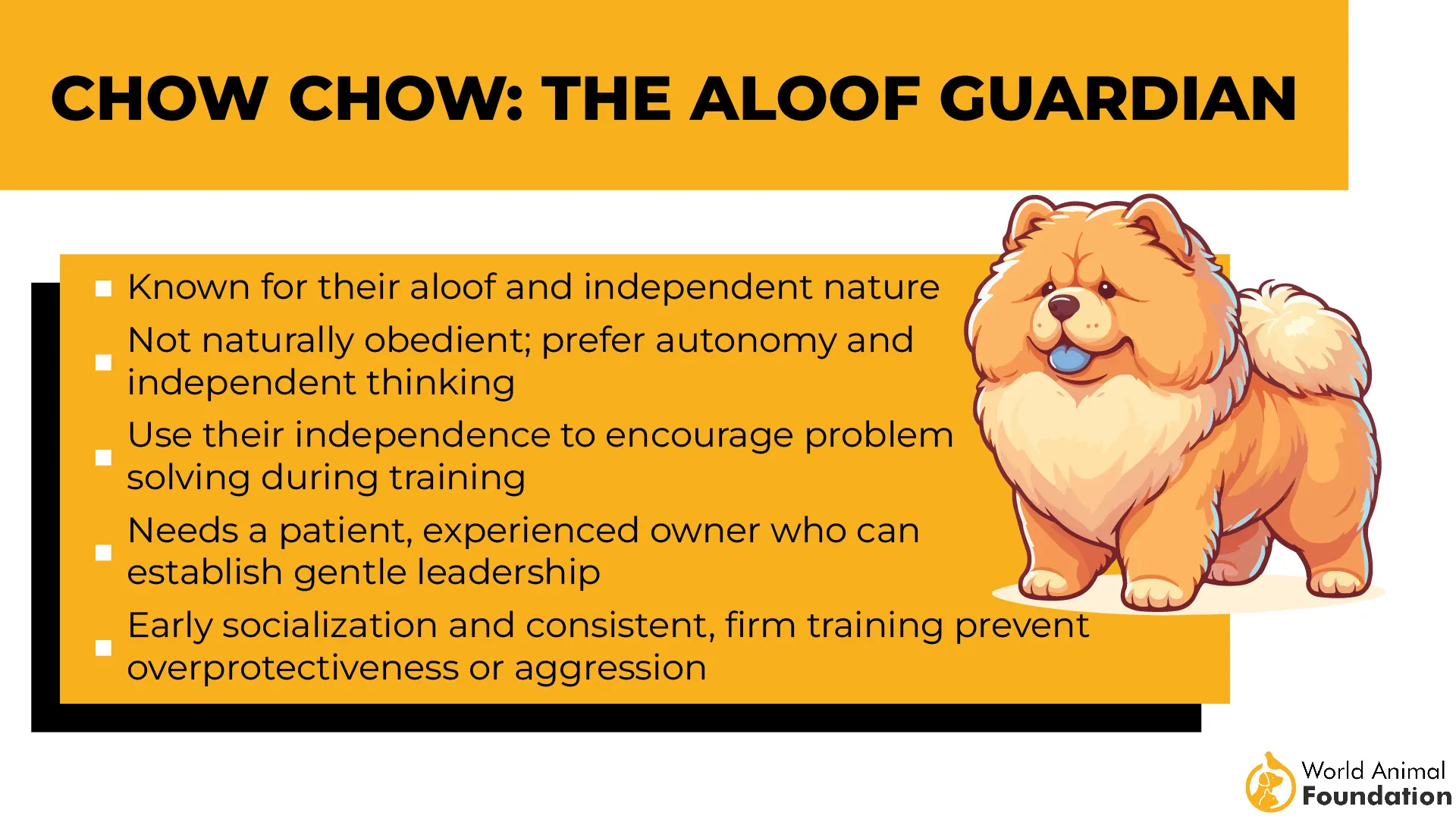
Petplan states they have heavy shedding periods, often called “blowing coat,” and they lose fur in clumps, requiring extra attention. Their thick double layer must be managed through frequent brushing and de-shedding techniques. Professional grooming services can be beneficial, especially during seasonal coat transitions, to keep their fur in top condition.
Owning a Chow Chow requires dedication, especially in grooming and training. Their coat demands consistent upkeep to stay healthy and tangle-free. Their dignified nature and striking appearance make them stand out, but only owners willing to invest time in regular care will fully appreciate their majestic presence.
5. Lhasa Apso

The Lhasa Apso is one of the most elegant long-haired dogs, known for its luxurious locks that require dedicated care. Originally bred in the Himalayas, this breed has a dense undercoat that provides insulation against cold temperatures.
While their coat adds to their charm, it also makes them a high-maintenance breed that demands daily grooming to prevent tangles and matting. Their fur can become knotted without proper upkeep, leading to discomfort and skin issues.
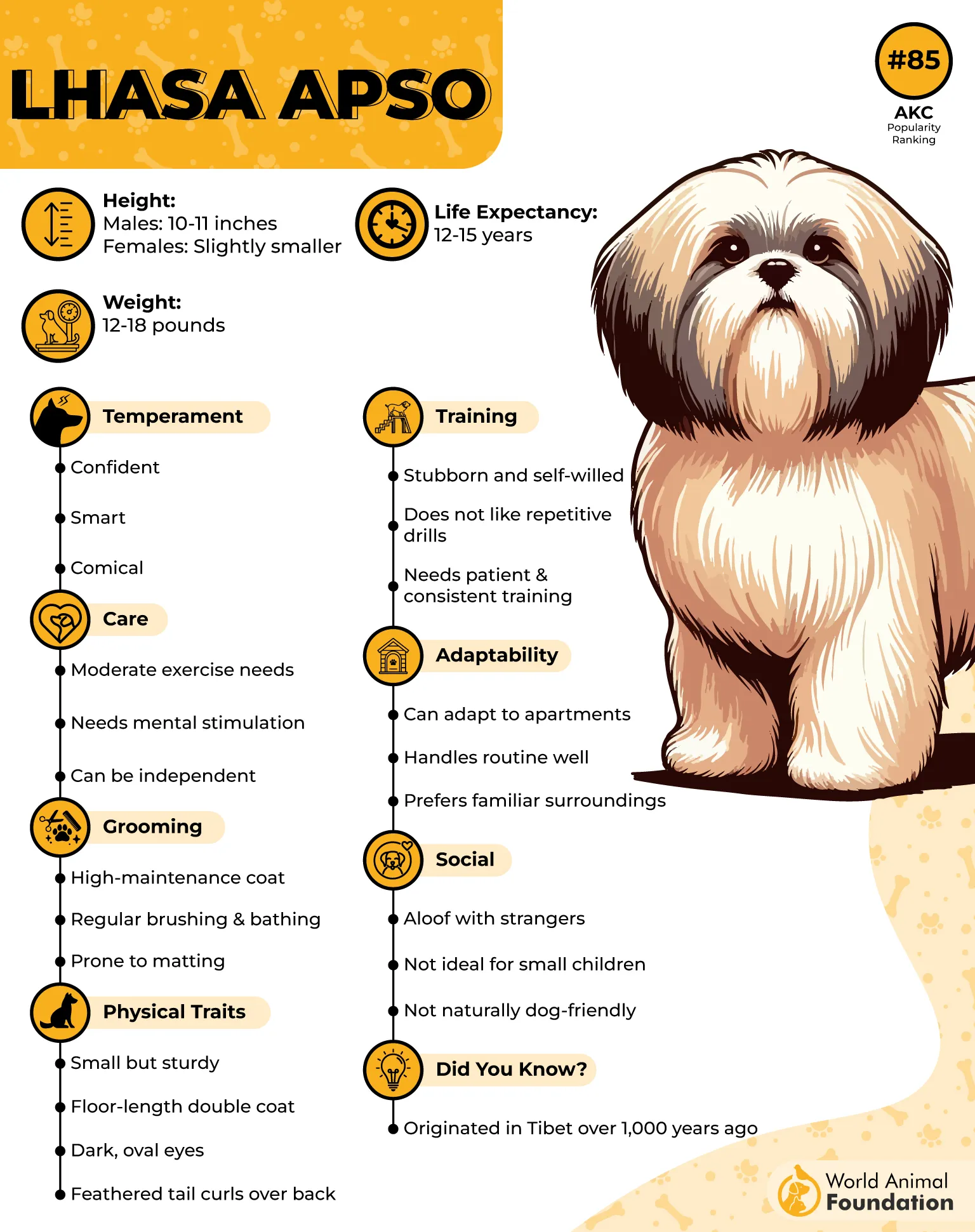
Grooming a Lhasa Apso is a time-intensive task requiring professional groomers to trim and maintain it. Their long, silky hair needs daily brushing to keep it in good shape and avoid painful mats.
Regular eye and ear cleaning is also essential, as their long fur can trap dirt and moisture, leading to infections. Many owners opt for shorter cuts to make grooming more manageable, but maintaining the breed’s signature coat requires patience and effort.
While daily grooming is crucial, occasional baths help keep their coat clean and shiny. Using mild, high-quality shampoos and conditioners prevents dryness and maintains their natural oils. Proper drying techniques are also important, as trapped moisture in their undercoat can irritate. Their coat care is more than just aesthetics—it directly affects their overall health and comfort.
Despite their small size and short legs, Lhasa Apsos have a big personality. Their independent and confident nature makes them loyal companions, but their grooming needs make them unsuitable for those looking for a low-maintenance pet. Regular coat maintenance ensures they remain comfortable, preventing common coat-related issues like tangles and excessive shedding.
Owning a Lhasa Apso means committing to a strict grooming routine and, in many cases, seeking help from professional groomers. Their striking appearance comes with responsibility, but with the right care, their beautiful flowing locks will stay healthy and elegant, making them a regal companion.
6. Pekingese
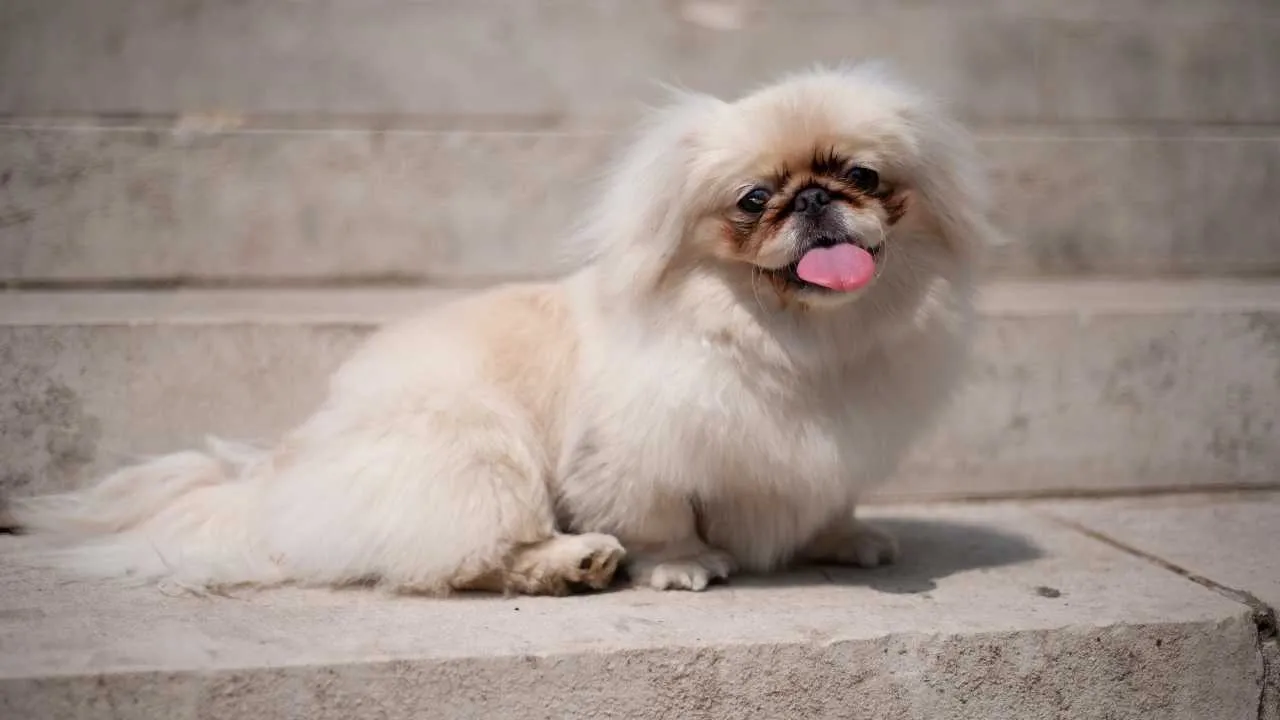
The Pekingese is a small yet majestic breed with a flowing, thick double coat. Originally bred for Chinese royalty, this breed boasts a luxurious mane that looks lion-like. While its beauty is undeniable, maintaining this coat requires dedication, patience, and the right grooming routine.
Pekingese fur is long, dense, and prone to tangles, making daily brushing essential. Without regular detangling, mats can form, leading to discomfort and potential skin infections.
A metal comb and a pin brush are ideal tools to keep their coat smooth and free of knots. Special attention is needed around the ears, legs, and chest, where fur matures most.
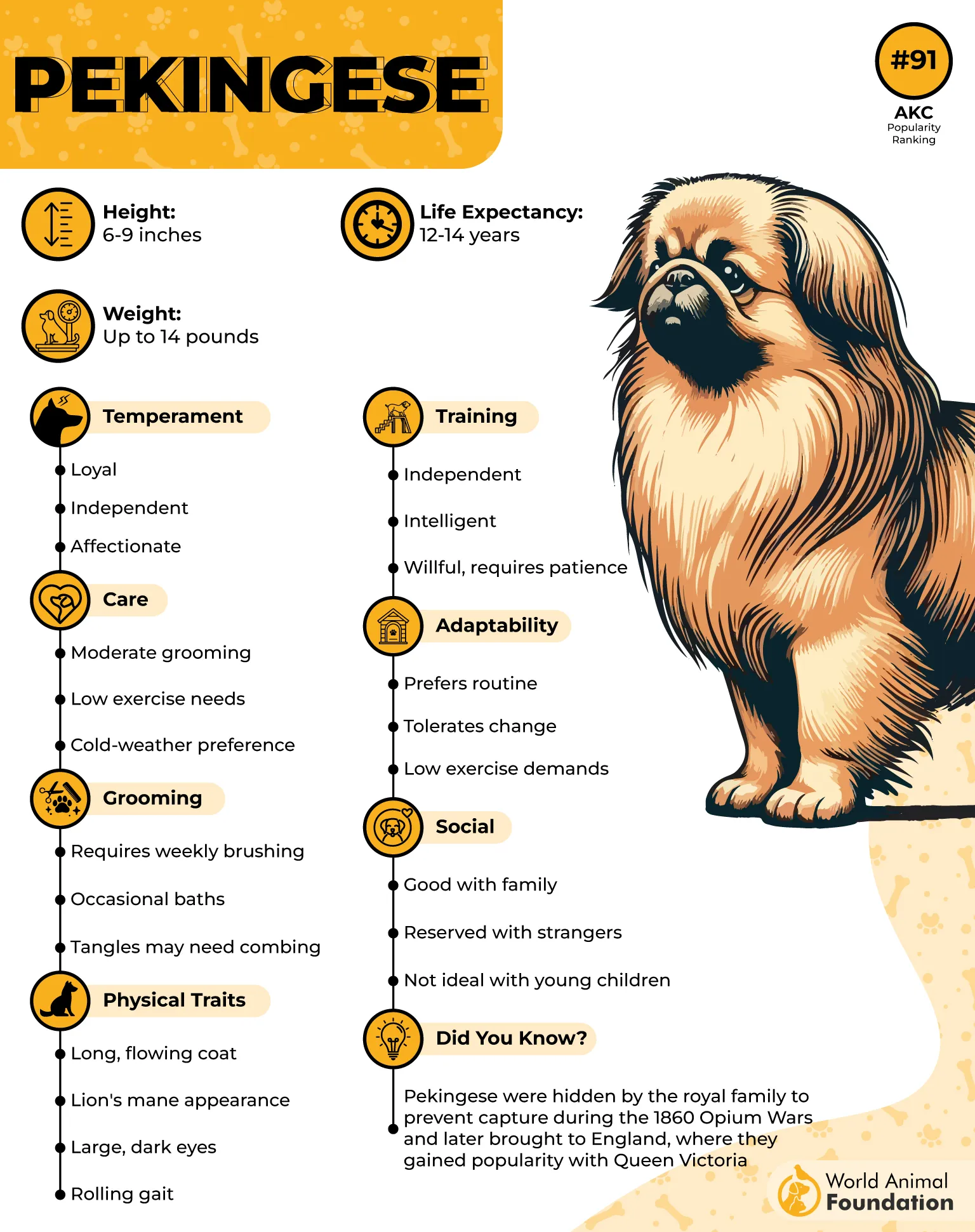
Bathing a Pekingese requires care, as their thick fur holds water and takes drying time. Using a gentle, dog-friendly shampoo ensures their coat remains soft and healthy. After bathing, thorough drying with a blow dryer on a low setting is crucial to prevent dampness, which can lead to skin irritation or fungal infections.
While at-home care is necessary, professional grooming is highly recommended. Trimming the fur around their paws and sanitary areas helps maintain cleanliness. Many owners opt for a shorter “puppy cut” to reduce daily maintenance, but even then, regular grooming appointments are essential to keep their coat in top condition.
The Pekingese’s coat isn’t just about aesthetics—it plays a role in their overall well-being. Regular eye cleaning prevents tear stains, and keeping their face dry helps avoid skin fold infections.
PDSA states they shed a lot throughout the year, especially in spring and autumn. A diet rich in omega fatty acids also supports coat health, ensuring their fur remains shiny and strong. With proper care, a Pekingese’s luxurious coat can stay as regal as the breed itself.
7. Komondor
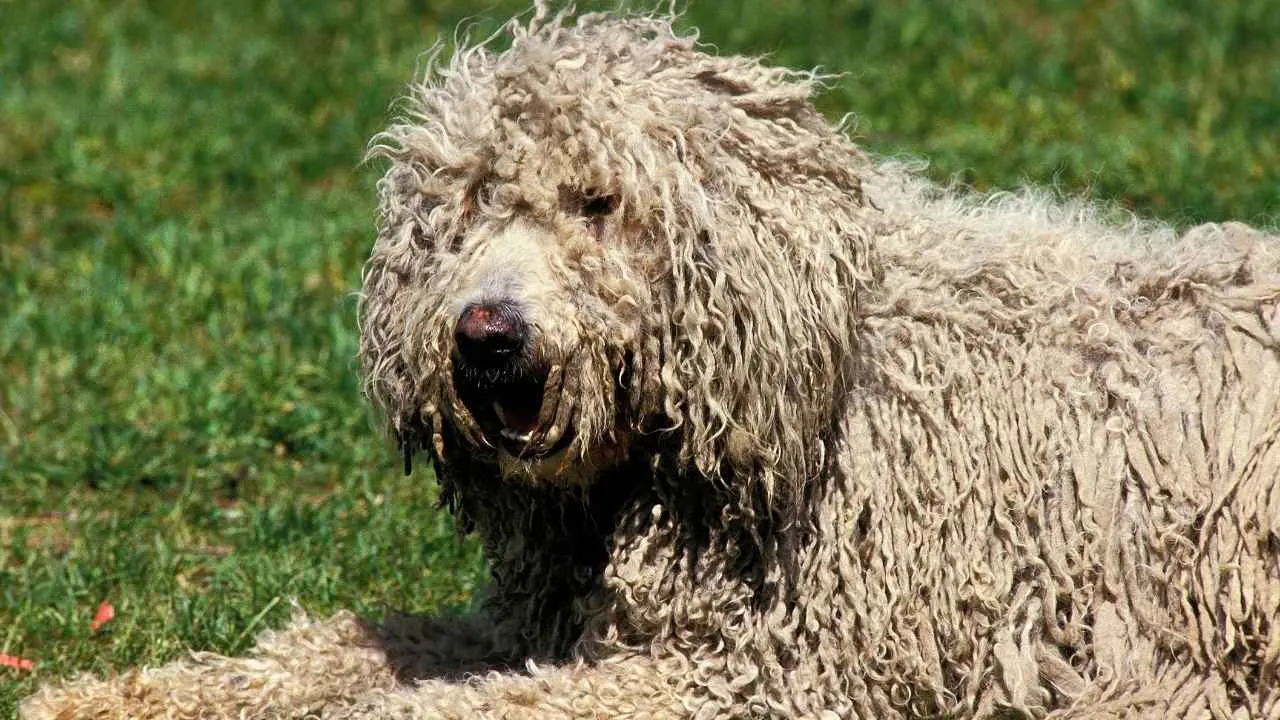
The Komondor is a unique herding dog known for its distinctive, corded coat that requires dedicated care. Its fur naturally forms long, rope-like cords that protect against harsh weather and predators. While it is low-shedding, it demands meticulous maintenance to prevent dirt buildup and unpleasant odors.
Grooming a Komondor is a specialized task that requires careful attention. Instead of regular brushing, owners must separate the cords by hand to keep them from matting into large, unmanageable clumps.
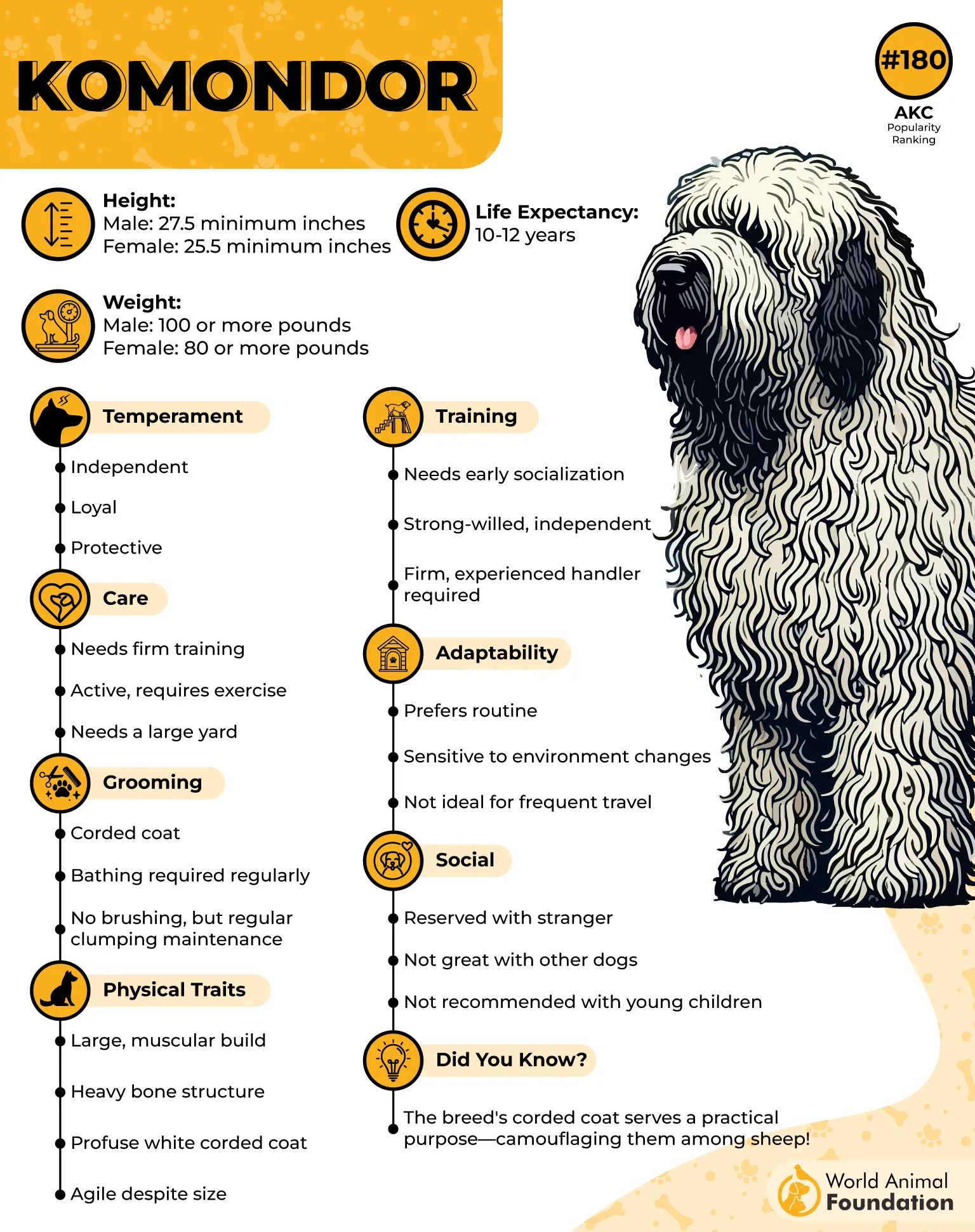
Bathing is time-consuming, as the thick cords absorb water like a sponge. Proper drying can take hours or even days, requiring patience and specialized care. Consulting a veterinarian for coat health and skin care tips is essential to prevent infections.
AKC states this highly smart and independent dog needs mental and physical stimulation beyond grooming. While not known for excelling in dog sports, it thrives in guarding and herding tasks. Its strong instincts and high prey drive make early training crucial for proper behavior. This breed requires firm and consistent leadership to develop into a well-mannered companion.
Regular exercise is just as important as grooming for a Komondor’s well-being. It prefers moderate activity but still needs daily movement to stay healthy. It is sensitive to heat and should be exercised in cooler conditions to prevent overheating. Its protective instincts make it naturally wary of strangers, making early socialization essential for balanced behavior.
Owning a Komondor is a commitment that goes beyond aesthetics. Its coat needs specialized attention to maintain its traditional, corded look. With the right care, this remarkable dog remains a loyal guardian and a striking presence, standing out as one of the most unique herding dogs in the world.
Conclusion
Owning a dog with a high-maintenance coat requires dedication, as certain breeds demand regular grooming to stay healthy and tangle-free. From the luxurious fur of the Shih Tzu and Yorkshire Terrier to the dense, weather-resistant coats of Border Collies and Siberian Huskies, each breed has unique grooming needs.
Dogs with curly coats, like the Poodle, Bichon Frise, and Portuguese Water Dog, require frequent brushing to prevent matting, while silky-haired breeds like the Cocker Spaniel need routine trimming to maintain their coat’s beauty. Proper care and commitment allow these dogs to remain comfortable, stylish, and free from coat-related health issues.


